Graphic drawings in the form of a dictation is a game for children of preschool and school age. Drawing on the cells, the child learns to navigate on the sheet, to logically build the direction of the movement of the hand line. He also learns to fix the angles on the cells and develops logical and spatial thinking.
Types of graphic dictations
Graphic dictations can be divided into 3 parts, when children complete tasks by drawing on the cells themselves or under dictation:
- The child must repeat the image in his notebook, counting the cells that are presented in the sample.
- In the 2nd case, the child traces the cells under dictation, listening to the teacher. He must say in which direction the child should move the pen, how many cells to pass.
- Self-dictation - the child has instructions where the task is described. There are also hints about how many cells to draw, in which direction.
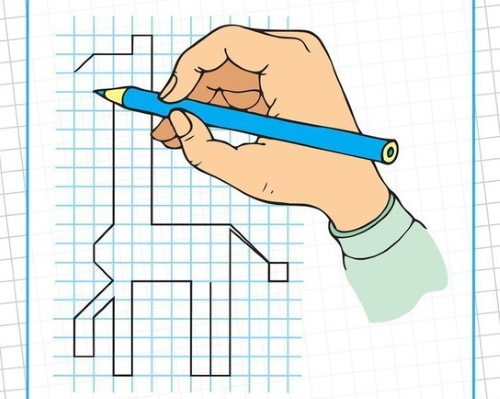
As a rule, the tasks use digital designations of steps. Next to them are arrows that orient the child in space. It is important that during these mathematical games the children are in a good mood and want to solve the example, having received a beautiful picture. The task of the adult is to help the child in an unobtrusive way to learn the possibilities of arithmetic operations.
Stages of conducting classes
It is worth noting that almost all dictations are supplemented with relaxing games, tongue twisters and finger exercises for relaxation.
During the lessons, children develop clear speech, fine motor skills of the hands and practice concentration on those things that require increased thoughtfulness - features of objects, replenishment of vocabulary (riddles for the resulting drawings).
The tasks are designed so that the child can solve examples "from simple to complex". According to the principle of the graphic method, children remember the sequence of numbers faster and easier, and develop orientation in the direction of movement.

To conduct classes you need:
- The main stage is a conversation between the teacher and the children. It is necessary to explain the task, rules and features of the game.
- The teacher asks to leave only a notebook with a grid, a pencil and an eraser on the desk in case the child gets confused or does not manage to complete a step.
Preschool children are given notebooks with a grid of up to 0.8 mm (large) to make it convenient to concentrate on finger movements. Small grids are too “complicated” for tracing and drawing, so 5-6 year olds need to be provided with comfort in the process itself.
Below is an example of a graphic dictation for a child aged 4-5 years:
| Stages | Step 1 | Step 2 | Step 3 | Step 4 | Step 5 | Step 6 | Step 7 | Step 8 |
| Block 1 | Right 1 | Up 3 | Right 2 | Up 1 | Right 1 | Down 3 | Right 6 | Up 1 |
| Block 2 | Right 1 | Up 1 | Right 1 | Down 2 | Left 1 | Down 4 | Left 1 | Down 2 |
| Block 3 | Left 3 | Up 1 | Right 1 | Up 1 | Left 2 | Down 1 | Left 1 | Down 1 |
| Block 4 | Left 2 | Up 1 | Right 1 | Up 2 | Left 1 | Top 1 | Left 3 | Up 1 |
The result should be a picture of a dog:
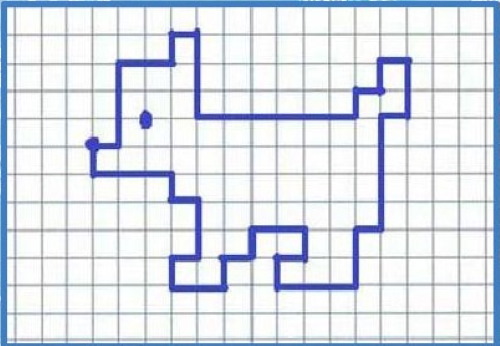
The duration of the dictation is no more than 10 minutes for preschool children aged 4-5 years. For children aged 6-7 years, the dictation lasts 20 minutes, since the tasks are more difficult, as a rule. And at school, children are given similar activities lasting a whole lesson. At the same time, the game cannot be interrupted.
If there are left-handed children among them, it is worth explaining that left and right are on the same sides as usual. For some children, there is a hint - you can put dots after counting the cells.
Before starting classes, you need to do finger exercises and at the same time explain the following points to the children:
- Each animal has a schematic interpretation - similarity with reality and what will ultimately be on the sheet.
- Photos may differ from each other, as may the colors of the fur, the sizes of the beaks. But the figure scheme is always the same.
- In graphic dictation, it is important to maintain the order of the cells - you cannot skip over 1, get confused, or finish drawing "from yourself" if someone did not have time to do something.
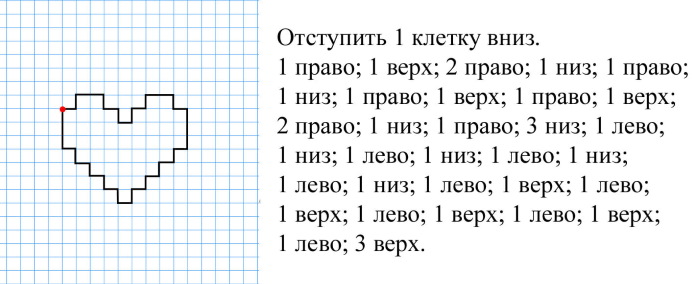
The schematic drawings have distinctive features:
- hares have long ears;
- elephant - big round ears;
- The ostrich has a long neck.
In this case, the shapes of a circle or oval are displayed schematically taking into account square cells. As an example, we can cite a mosaic that also shows the formation of shapes based on non-circular outlines of holes.
Rules and tips for implementation
Graphic drawings on the cells should be done after the teacher’s introductory speech, a conversation with the class (group of children) and preparation:
- Let the child take the ball in his hands and throw it up several times.
- Then, for each syllable of the tongue twister (pure twister), the baby must catch the ball. This is how a sense of tact and understanding of sequence develops. Children will not be in a hurry.
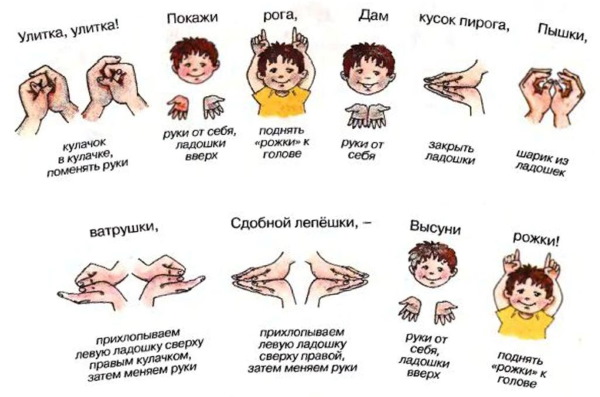
- The ball can be replaced by clapping your hands - for each syllable the child claps.
- Finger gymnastics allows you to prepare children for the task. To keep the kids busy, you can hand out sheets of paper and pencils while reading and telling tongue twisters.
- Next, you need to explain the game plan so that the children are not afraid of being late in completing the work.
- Before you start, you should read the rules of the game several times, and then use an example to show what can happen if you follow all the points correctly and consistently.
Before dictating a task to children, you need to ask them to put a dot - this is the beginning from which the drawing will "grow". It is important that the dot is not on the edge or in the middle of the drawing, which takes up a lot of space on the work surface.
Drawing by cells for children (diagrams and templates)
Graphic dictation can be conducted in a group, as well as in individual lessons with children.
If in the second case it is quite easy to select the desired drawing, then in the first case the teacher must select children by age (extracurricular activities).
For preschoolers (5-6 years)
The child should sit at the table and listen attentively to the teacher's instructions. First, it is worthwhile to talk through the conditions and explain the essence of the entire task. Children aged 5-6 years can already distinguish shapes, colors, explain the choice of a color scheme, and speak in a structured manner about the capabilities of the drawn character.
Children in adolescence are talented, and it is important to help them develop their abilities, and not "kill" the sense of beauty. Therefore, scolding is absolutely forbidden. The child must understand that he has the right to stray, to lag behind other peers, and nothing will happen to him for this - this is a game where there are no strict rules that apply to behavior or individual abilities of the individual.

For work children will need:
- pencil;
- eraser;
- a sheet of paper in a large grid;
- example of a task.
Next, you need to explain that the drawing will be created in such a way that the child does not have to lift the pen or pencil from the sheet. That is, continuous, slow drawing of lines.
If the child gets confused, you need to tell him to continue from where he left off. As a rule, towards the end of the dictation, many can already determine the type of animal or image by the figure. Some finish drawing the figure themselves - there is no need to scold them for this.
Graphic drawings on cells are carried out as follows:
- The teacher says, "Put a dot in the upper left corner." This will be the beginning of the drawing.
- Next, you need to dictate each step without repeating yourself, giving the child 10-15 seconds to think.
- The simplest figures are those that can be drawn using the tasks “golden key”, “bunny” and “elephant”.

To draw an "elephant" you should follow these steps:
- put a dot in the upper left corner;
- go 4 cells to the right, 1 down, 5 to the right;
- then 8 cells down, 3 to the left, 3 up, 1 to the left, 3 down, 3 to the left;
- at the end 4 cells up, 1 left, 2 down, 1 left, 1 down, 1 left;
- and for the trunk - 2 cells up, 1 to the right, 6 up.
For the "golden key" task:
- put a dot in the middle of the sheet and count 8 cells to the right from it;
- from the 8th cell: 2 up, 4 right, 5 down, 4 left, 2 up;
- 4 left, 4 down;
- 1 left, 1 up, 1 left, 1 down, 1 left;
- 3 up, 1 left, 1 up.
To make it more understandable and convenient for the child, you can offer a drawing diagram as a visual example, placing it in front of the child’s eyes on the table.

This is especially convenient for drawing a "bunny":
- First, you need to step back from the edge of the sheet 5 cells on the right and 3 on the top.
- From the set point you can start the drawing: 1 cell to the right, 3 down, 2 to the right, 2 down, 1 to the left.
- Then draw 2 cells down, 3 to the right, 3 down, 1 to the left, 1 up.
- For paws: 1 left, 2 down, 1 right, 2 down, 2 right, 1 down, 6 left.
- Then for the tail: 1 up, 1 left, 1 up, 1 right, 12 up.
The result is a hare in profile, which fills the right side of the sheet. At the beginning of the dictation, the children were able to step back a place, and the drawing turned out. It is important to note this, otherwise the child will not understand why certain actions were performed. You can come up with names, poems, stories for each drawing.
Give the children a homework assignment - think of what color the drawing will be, how best to depict it. Also, smart kids will like to independently come up with dictations based on ready-made drawings.
For schoolchildren aged 7-8
Numerical dictations help children adapt to school well – they understand arithmetic and mathematical tasks better.
Children of 7 years old learn spatial orientation, independence in performing important tasks. In primary school, the teacher must establish contact with each child and, in order to understand his level of preparation, graphic dictations can be given as tasks.
Children learn information better:
- They learn to decipher riddles and solve problems.
- The child already knows how to navigate the knowledge base, relying on the preschool program.
- Dictation helps teach children to listen and grasp the essence of problems.
The most interesting tasks for schoolchildren are those of the "Christmas tree" type. Before starting, you need to put dots on the students' sheets of paper, then dictate the task or give them a task template. It should contain numbers and arrows indicating the direction of the line's movement. In this case, 1 step is equal to 1 arrow.

It is also important for children to understand:
- The vertical and horizontal planes are indicated by arrows pointing to the right and left.
- Diagonal arrows are the movement of lines diagonally.
- For each correct task you need to praise, for distraction - scold. This way the child will maintain discipline and not be distracted by peers or extraneous activities.
To complete the task, you need to prepare paper and a pencil:
- First, you should specify how much indentation you want from the edge of the paper.
- Then you can start doing: 3 cells to the right, 11 down, 2 to the right, 5 up.
- Then 3 cells to the right, 5 down, 1 to the right, 3 up, 3 to the right, 3 down, 1 to the right.
- Then 3 up, 2 right, 1 down and 1 left.
- Then the drawing comes to an end: 3 down, 3 left, 3 up, 1 left, 3 down, 3 left.
- Next 5 up, 1 left, 5 down, 4 left, 9 up, 2 left and 3 up.
The result will be a snake.
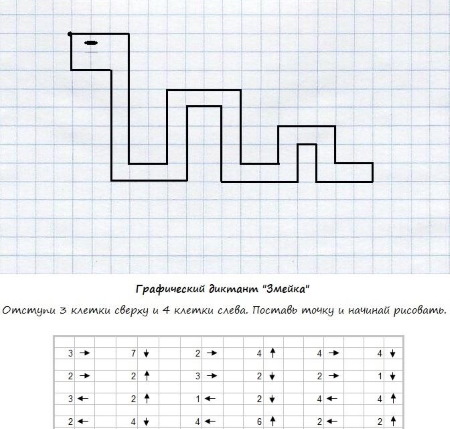
For clarity, children can be given schematic assignments:

The duck should be in the center of the sheet.

You can draw a house with your parents as homework.
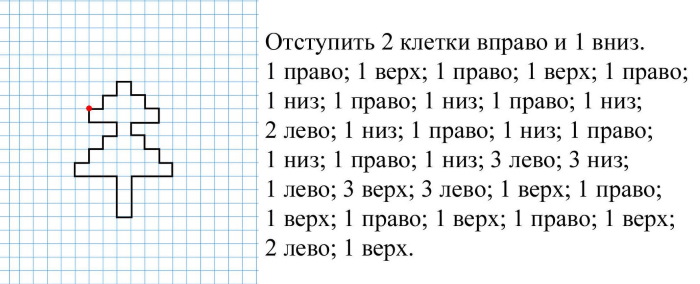
A tree with 2 tiers is a bit more difficult to make, so it is better to ask the child to read the task at home on his own, and then draw the dictation in class after training.

This drawing is interesting because of its scale: one sheet can hold a large figure, which can then be colored.
Older children (finishing 2nd grade) can be given assignments in diagrams:

After finishing the giraffe, you can color it to your taste. The child should also select colors and, without going beyond the contours, make a smooth transition from light to dark.
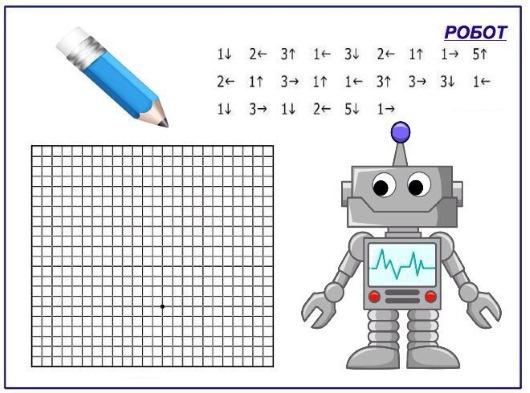
And this dictation will be an excellent task for a child of 8-9 years. As you can see, each drawing has a point that you need to independently transfer to the notebook. Only from it can you start the task, since the shift can lead to an interruption of the line.
For children 9-10 years old
Children in grades 3-4 already know the features of constructing figures, can work with geometric data, calculate the parameters of objects (equations). Examples can be given online as homework. There is a service that provides such an opportunity for schoolchildren. Together with parents or brothers/sisters, such tasks will seem simple.
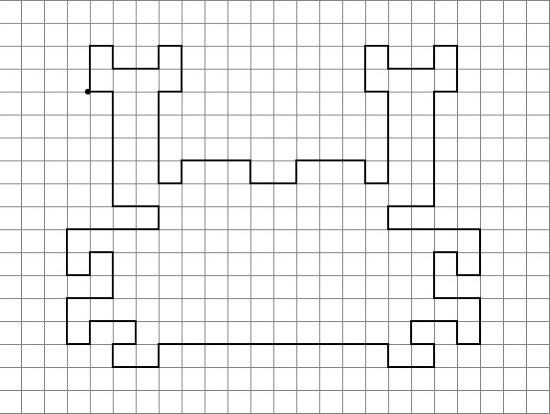
To draw a crab, you need to do the following:
- Move 4 cells from the top and the same number to the left;
- Draw 2 up, 1 right, 1 down, 2 right, 1 up, 1 right;
- 2 down 1 left, 4 down, 1 right, 1 up, 3 right, 1 down and 2 right;
- 1 up, 3 right, 1 down, 1 right and 4 up;
- 1 left, 2 up, 1 right, 1 down, 2 right, 1 up, 1 right and 2 down;
- 1 left 5 down, 2 left, 1 down, 4 right, 2 down 1 left, 1 up and 1 left;
- 2 down and 2 right, 2 down and 1 left;
- 1 up, 2 left, 1 down, 1 right and 1 down;
- 2 left, 1 up and 10 left;
- 1 down, 2 left, 1 up, 1 right, 1 up, 2 left, 1 down and 1 left;
- 2 up, 2 right, 2 up, 1 left, 1 down, 1 left and 2 up;
- 4 right, 1 up, 2 left, 5 up and 1 left.
As you can see, the figure is symmetrical and upon reaching the middle of the task, the child can already schematically move in a mirror direction. This allows for the development of thinking and abstract perception.
Symmetrical (mirror) drawing by cells
Graphic drawings by cells can be done without additional tasks - you need to rely not on numbers and arrows, but on the image itself.
In this case, shown below, the child sees an unfinished house, which is done schematically. The cells will tell in which direction to move, how many cells to finish drawing in one direction or another.
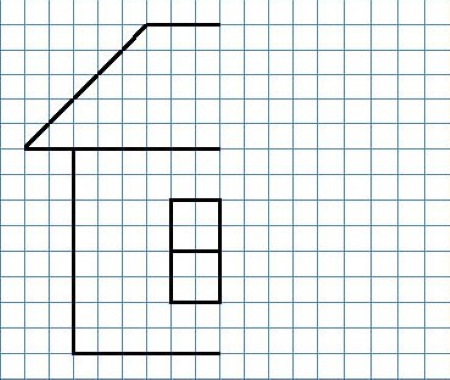
Such activities are interesting for older children who already understand what mirroring and symmetry are. That is, if you fold the drawing in half, you will get ½ of the entire image, which means you need to mirror the lines that are already on the sheet.
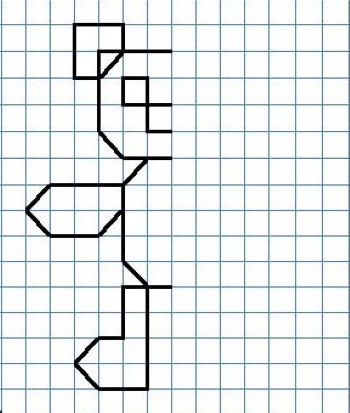
Drawings can be different, and there is no point in indicating the direction of the hand movement. The child understands at what distance the square is removed, how to repeat it in mirror image, so that in the end a symmetrical "analogue" of what is before the eyes is obtained.
Graphic drawings should develop children's thinking, help them better master the school curriculum. It is not without reason that such games can be found on the Internet, and the whole family can do them. If drawing on the cells does not work out, perhaps the child will develop other interests - artistic interpretation, an attraction to music or a passion for other sports/activities.
The main thing is that the school minimum does not cause a negative reaction, then mathematics will be a joy not only in the 1st, but also in the 10th grade.
Video about graphic drawings
Graphic drawings by cells - robot:

🙂 🙂 🙂 🙂 🙂 🙂 🙂